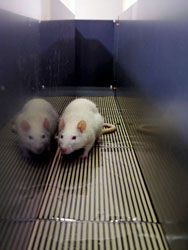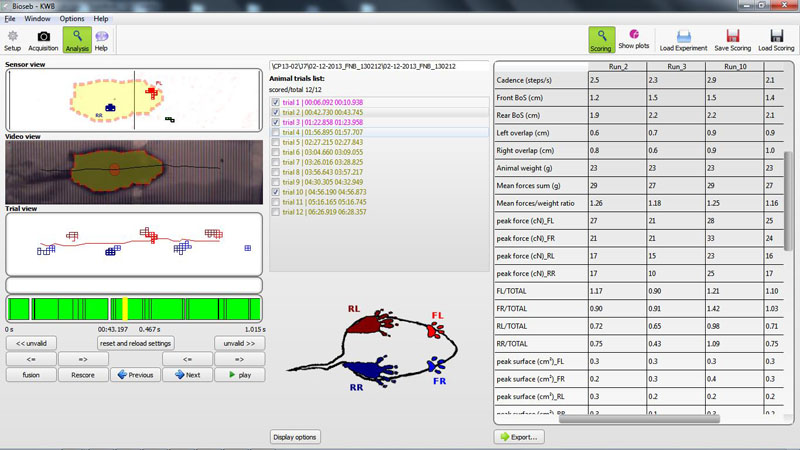
A unique setup for the automation of the Open Field test for rats and mice : 3D-camera based technology is now capable of direct height...
 Pain - Thermal Allodynia / Hyperalgesia
Pain - Thermal Allodynia / Hyperalgesia Pain - Spontaneous Pain - Postural Deficit
Pain - Spontaneous Pain - Postural Deficit Pain - Mechanical Allodynia / Hyperalgesia
Pain - Mechanical Allodynia / Hyperalgesia Learning/Memory - Attention - Addiction
Learning/Memory - Attention - Addiction Physiology & Respiratory Research
Physiology & Respiratory Research
A unique setup for the automation of the Open Field test for rats and mice : 3D-camera based technology is now capable of direct height...
Discover our productsA unique device that provides automated measurement of weight bearing and force distribution over time during voluntary gait. Synchronized video tracking and force transducers measure gait dynamics, for a voluntary multi-step sequence as a subject (rat or mouse) traverses a corridor to its home cage.
KWB is an innovative instrument for your research on analgesia, nociception and neuroscience, especially suited for work on Parkinson's disease, arthritis, spinal cord injury and more.
![]()
![]()
![]() Presentation
Presentation

BIOSEB Kinetic Weight Bearing (KWB), like the BIOSEB Dynamic Weight Bearing (DWB) instrument represents a giant leap forward in incapacitance testing where weight bearing on each paw is continuously and independently measured and analyzed automatically. The KWB instrument provides information on applied weight as well as the speed and acceleration of each paw during a voluntary walking sequence.. These data provide information about coordination and gait through paw to paw and step to step comparisons.
Gait analysis has been extensively used in phenotyping of CNS diseases such as cerebral ischemia, neurodegenerative diseases, spinal cord injury models and some pain models like neurotrauma (Nerve Crush, SNI). BIOSEB has extended existing gait analysis by including the measurement of the force applied by each individual paw to the floor the animal is walking upon.![]() Operating principle
Operating principle
The subject initiates a voluntary walking sequence from a starting chamber, across a corridor, to its home cage. The supplied KWB software synchronizes the aerial video capture with the pressure applied by each paw in real time using an array of 4,000 (mosue) or 6,000 (rat) sensors during the walking sequence. Automated parameter analysis for each paw such as Maximum Force (mN), Mass Velocity (N/s), and Maximum surface area (cm2)are reported along with gait dynamics such speed, cadence, overlaps, and step patterns are all compared across paws and steps and statistically processed.
BIOSEB has demonstrated that the rising time to the maximum force of each animal step differs across animal models. The KWB is able to compare the path of the animal's 'Geometric Center of Gravity' with the actual 'Weighted Center of Gravity', and show significant differences. Changes in weight distribution from left to right, front to back and contra-lateral compensation are easily measured, thus providing useful information for your research work on nociception and analgesia.

![]() Supplied with
Supplied with
• Elevated stand
• Mouse and Rat home cages
• Sensors mat x 2 + interfaces
• HD USB camera
• KWB Software license: allows you to install the full software on 1 computer, and the software in 'replay' mode on as many computers as needed!
Data sheet
Number of publications:
An easy way to objectively quantify the muscular strength of mice and rats, and to assess the effect of drugs, toxins,...
The BIOSEB Spontaneous Activity Wheel is an easy way to quantify rodent voluntary activity in their home cage environment....
The uncomplicated way to monitor rodent activity over several days from their home cage without manual...
check_circle
check_circle